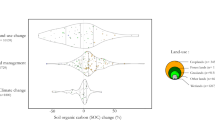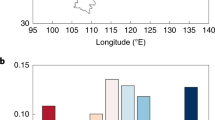Abstract
Mangrove soils represent a large sink for otherwise rapidly recycled carbon (C). However, widespread deforestation threatens the preservation of this important C stock. It is therefore imperative that global patterns in mangrove soil C stocks and their susceptibility to remineralization are understood. Here, we present patterns in mangrove soil C stocks across hemispheres, latitudes, countries and mangrove community compositions, and estimate potential annual CO2 emissions for countries where mangroves occur. Global potential CO2 emissions from soils as a result of mangrove loss were estimated to be ∼7.0 Tg CO2e yr−1. Countries with the highest potential CO2 emissions from soils are Indonesia (3,410 Gg CO2e yr−1) and Malaysia (1,288 Gg CO2e yr−1). The patterns described serve as a baseline by which countries can assess their mangrove soil C stocks and potential emissions from mangrove deforestation.
This is a preview of subscription content, access via your institution
Access options
Access Nature and 54 other Nature Portfolio journals
Get Nature+, our best-value online-access subscription
$29.99 / 30 days
cancel any time
Subscribe to this journal
Receive 12 print issues and online access
$209.00 per year
only $17.42 per issue
Buy this article
- Purchase on Springer Link
- Instant access to full article PDF
Prices may be subject to local taxes which are calculated during checkout






Similar content being viewed by others
Change history
27 November 2017
In the version of this Article originally published, the potential carbon loss from soils as a result of mangrove deforestation was incorrectly given as '2.0–75 Tg C yr−1; this should have read '2–8 Tg C yr−1;'. The corresponding emissions were incorrectly given as '~7.3–275 Tg of CO2e'; this should have read '~7–29 Tg of CO2e'. The corresponding percentage equivalent of these emissions compared with those from global terrestrial deforestation was incorrectly given as '0.2–6%'; this should have read '0.6–2.4%'. These errors have now been corrected in all versions of the Article.
References
Hamilton, S. & Casey, D. Creation of high spatiotemporal resolution global database of continuous mangrove forest cover for the 21st century: a big-data fusion approach. Glob. Ecol. Biogeogr. 25, 729–738 (2016).
Donato, D. C. et al. Mangroves among the most carbon-rich forests in the tropics. Nat. Geosci. 4, 293–297 (2011).
Twilley, R. R., Chen, R. & Hargis, T. Carbon sinks in mangroves and their implications to carbon budget of tropical coastal ecosystems. Wat. Air Soil Pollut. 64, 265–288 (1992).
Bouillon, S. et al. Mangrove production and carbon sinks: a revision of global budget estimates. Glob. Biogeochem. Cycles 22, GB2013 (2008).
Mcleod, E. et al. A blueprint for blue carbon: toward an improved understanding of the role of vegetated coastal habitats in sequestering CO2 . Front. Ecol. Environ. 9, 552–560 (2011).
Alongi, D. M. Carbon sequestration in mangrove forests. Carbon Manage. 3, 313–322 (2012).
Duarte, C. M., Losada, I. J., Hendriks, I. E., Mazarrasa, I. & Marbà, N. The role of coastal plant communities for climate change mitigation and adaptation. Nat. Clim. Change 3, 961–968 (2013).
Jardine, S. L. & Siikamäki, J. V. A global predictive model of carbon in mangrove soils. Environ. Res. Lett. 9, 104013 (2014).
Siikamäki, J., Sanchirico, J. N. & Jardine, S. L. Global economic potential for reducing carbon dioxide emissions from mangrove loss. Proc. Natl Acad. Sci. USA 109, 14369–14374 (2012).
Murdiyarso, D. et al. The potential of Indonesian mangrove forests for global climate change mitigation. Nat. Clim. Change 5, 8–11 (2015).
Alongi, D. M. Present state and future of the world’s mangrove forests. Environ. Conserv. 29, 331–349 (2002).
Lovelock, C. E. et al. The vulnerability of Indo-Pacific mangrove forests to sea-level rise. Nature 526, 559–563 (2015).
Giri, C. et al. Status and distribution of mangrove forests of the world using earth observation satellite data. Glob. Ecol. Biogeogr. 20, 154–159 (2011).
Pendleton, L. et al. Estimating global ‘blue carbon’ emissions from conversion and degradation of vegetated coastal ecosystems. PLoS ONE 7, e43542 (2012).
Fourqurean, J. W. et al. Seagrass ecosystems as a globally significant carbon stock. Nat. Geosci. 5, 505–509 (2012).
IPCC Climate Change 2007: The Physical Sciences Basis (eds Solomon, S. et al.) (Cambridge Univ. Press, 2007).
Atwood, T. B. et al. Country-Level Mangrove Soil Carbon Stocks and Losses Dataset. http://dx.doi.org/10.1594/PANGAEA.874382 (Pangaea, 2017).
Hutchison, J., Manica, A., Swetnam, R., Balmford, A. & Spalding, M. Predicting global patterns in mangrove forest biomass. Conserv. Lett. 7, 233–240 (2014).
Field, C. B. et al. Mangrove biodiversity and ecosystem function. Glob. Ecol. Biogeogr. Lett. 7, 3–14 (1998).
Datta, D., Chattopadhyay, R. N. & Guha, P. Community based mangrove management: a review on status and sustainability. J. Environ. Manage. 107, 84–95 (2012).
Ferreira, A. C. & Lacerda, L. D. Degradation and conservation of Brazilian mangroves, status and perspectives. Ocean Coast. Manage. 125, 38–46 (2016).
Sanders, C. J. et al. Are global mangrove carbon stocks driven by rainfall? J. Geophys. Res. Biogeosci. 10, 2600–2609 (2016).
Friess, D. A. & Webb, E. L. Variability in mangrove change estimates and implications for the assessment of ecosystem service provision. Glob. Ecol. Biogeogr. 23, 715–725 (2014).
Adame, M. F. et al. Carbon stocks of tropical coastal wetlands within the karstic landscape of the Mexican Caribbean. PLoS ONE 8, e56569 (2013).
van der Werf, G. R. et al. CO2 emissions from forest loss. Nat. Geosci. 2, 737–738 (2009).
Lovelock, C. E., Ruess, R. W. & Feller, I. C. CO2 efflux from cleared mangrove peat. PLoS ONE 6, e21279 (2011).
Kauffman, J. B. et al. Carbon stocks of mangroves and losses arising from their conversion to cattle pastures in the Pantanos de Centla, Mexico. Wetl. Ecol. Manage. 24, 203–216 (2016).
Kauffman, J. B., Heider, C., Norfolk, J. & Payton, F. Carbon stocks of intact mangroves and carbon emissions arising from their conversion in the Dominican Republic. Ecol. Appl. 24, 518–527 (2014).
Donato, D. C. et al. Mangroves among the most carbon-rich forests in the tropics. Nat. Geosci. 4, 293–297 (2011).
Sidik, F. & Lovelock, C. E. CO2 efflux from shrimp ponds in Indonesia. PLoS ONE 8, 6–9 (2013).
Harris, N. L. et al. Baseline map of carbon emissions from deforestation in tropical regions. Science 336, 1573–1576 (2012).
Halpern, B. S. et al. Patterns and emerging trends in global ocean health. PLoS ONE 10, e0117863 (2015).
Ilman, M., Dargusch, P., Dart, P. & Onrizal. A historical analysis of the drivers of loss and degradation of Indonesia’s mangroves. Land Use Policy 54, 448–459 (2016).
Ahmed, N. & Glaser, M. Coastal aquaculture, mangrove deforestation and blue carbon emissions: is REDD + a solution? Mar. Policy 66, 58–66 (2016).
Valiela, I., Bowen, J. L. & York, J. K. Mangrove forests: one of the world’s threatened major tropical environments. Bioscience 51, 807–815 (2001).
Fish to 2030: Prospects for Fisheries and Aquaculture. Discussion paper no. 3 (World Bank, 2013); http://documents.worldbank.org/curated/en/458631468152376668/Fish-to-2030-prospects-for-fisheries-and-aquaculture
Armitage, D. Socio-institutional dynamics and the political ecology of mangrove forest conservation in Central Sulawesi, Indonesia. Glob. Environ. Change 12, 203–217 (2002).
Richards, D. R. & Friess, D. A. Rates and drivers of mangrove deforestation in Southeast Asia, 2000–2012. Proc. Natl Acad. Sci. USA 113, 344–349 (2016).
Kauffman, J. B. & Donato, D. C. Protocols for the measurement, monitoring, and reporting of structure, biomass and carbon stocks in mangrove forests. CIFOR Work. Pap. 86. Cent. Int. For. Res. Bogor, Indones.
Kennedy, H., Alongi, D. M. & Karim, A. CHAPTER 4: Coastal Wetlands. 2013 Supplement to the 2006 IPCC Guidelines for National Greenhouse Gas Inventories: Wetlands (2013); http://www.ipcc-nggip.iges.or.jp/public/wetlands
Bhomia, R. K., Kauffman, J. B. & McFadden, T. N. Ecosystem carbon stocks of mangrove forests along the Pacific and Caribbean coasts of Honduras. Wetl. Ecol. Manage. 24, 187–201 (2016).
Acknowledgements
Support was provided by the CSIRO Coastal Carbon Biogeochemistry Cluster. We also acknowledge the support of The Oceans Institute of the University of Western Australia, the Global Change Institute of The University of Queensland, and the Australian Research Council (Awards DE130101084, DE170101524, LP160100242, LE140100083 and DP150103286) and King Abdullah University of Science and Technology (KAUST) through the baseline fund to C.M.D. We would like to thank P. Terletzky-Gese for assistance with GIS.
Author information
Authors and Affiliations
Contributions
T.B.A., R.M.C., and C.E.L. designed the study. T.B.A., C.E.L., H.A., P.E.C., C.M.D., C.J.E.L., X.I., J.J.K., P.S.L., P.I.M., O.S., C.J.S., I.S. and A.D.L.S. contributed data. T.B.A. analysed the data and drafted the first version of the manuscript. All authors contributed to the writing and editing of the manuscript.
Corresponding author
Ethics declarations
Competing interests
The authors declare no competing financial interests.
Supplementary information
Supplementary Information
Supplementary Information (PDF 450 kb)
Rights and permissions
About this article
Cite this article
Atwood, T., Connolly, R., Almahasheer, H. et al. Global patterns in mangrove soil carbon stocks and losses. Nature Clim Change 7, 523–528 (2017). https://doi.org/10.1038/nclimate3326
Received:
Accepted:
Published:
Issue Date:
DOI: https://doi.org/10.1038/nclimate3326
This article is cited by
-
The inclusion of Amazon mangroves in Brazil’s REDD+ program
Nature Communications (2024)
-
Rapid greening in mangroves
Nature Ecology & Evolution (2024)
-
Research on hotspots and evolutionary trends of blue carbon sinks: a bibliometric analysis based on CiteSpace
Environment, Development and Sustainability (2024)
-
Congruence among taxonomic, functional, and phylogenetic diversity of mangrove crabs in the Southwestern Atlantic
Marine Biology (2024)
-
Determining Environmental Drivers of Fine-Scale Variability in Blue Carbon Soil Stocks
Estuaries and Coasts (2024)



